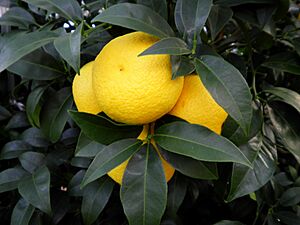Japanese citrus facts for kids
Japan is famous for many things, and one of them is its amazing citrus fruits! These juicy fruits are a big part of Japanese food and culture. Many of these special fruits originally came from China, but over time, they have been grown and changed in Japan to create unique types you can only find there. Think of them like super cool cousins of the oranges and lemons you know!
Meet the Japanese Citrus Fruits!
There are many different kinds of citrus fruits grown in Japan. Each one has its own special taste, smell, and look. Some are sweet, some are sour, and some are used for cooking or drinks. Here is a list of some of the most interesting Japanese citrus fruits:
| Common name(s) |
Image | What it is | Fun Facts |
|---|---|---|---|
| Amanatsu |  |
Citrus x natsudaidai | This fruit is yellowish-orange and about the size of a grapefruit. It has a slightly flattened shape and contains about 12 sections. |
| Banpeiyu (pomelo cultivar) |  |
Citrus maxima | The Banpeiyu is a type of pomelo, which is the largest citrus fruit. It's known for its thick rind and sweet, juicy flesh. |
| Bushukan (Buddha's hand) |  |
Citrus medica var. sarcodactylis | This fruit looks like a hand with many "fingers"! It's mostly rind and doesn't have much juice or pulp. It's often used for its strong, sweet smell. |
| Daidai |  |
Citrus × daidai | The Daidai is a bitter orange. It's often used in traditional Japanese New Year decorations and in cooking. |
| Dekopon |  |
Citrus unshiu x sinensis x C. poonensis | The Dekopon is famous for its bumpy top, like a small hat! It's very sweet and easy to peel, making it a popular snack. |
| Haruka |  |
Citrus tamurana x natsudaidai | Haruka means "spring scent" in Japanese. This fruit has a mild, sweet taste and a lovely fragrance. |
| Hassaku orange |  |
Citrus x hassaku | The Hassaku orange is known for its slightly bitter taste and firm texture. It's often eaten fresh. |
| Hyuganatsu | 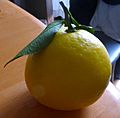 |
Citrus tamurana | This fruit has a bright yellow rind and a unique sweet-sour flavor. People often eat it with a sprinkle of sugar. |
| Iyokan |  |
Citrus x iyo | The Iyokan is a popular citrus fruit in Japan. It's known for its rich, sweet taste and strong aroma. |
| Jabara | 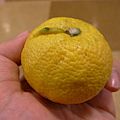 |
Citrus x jabara | The Jabara is a rare citrus fruit. It's known for having special compounds that might help with allergies. |
| Kabosu |  |
Citrus sphaerocarpa | Kabosu is a sour green citrus, similar to a lime. It's often used to add a tangy flavor to Japanese dishes, especially fish. |
| Karatachi (Japanese bitter orange) |  |
Citrus trifoliata | This is a very sour and bitter orange. It's mostly used as a rootstock for grafting other citrus trees. |
| Kanpei |  |
Citrus x natsudaidai | The Kanpei is a newer type of citrus. It's known for being very juicy and having a sweet, refreshing taste. |
| Kawachi Bankan (Mishokan) |  |
Citrus kawachiensis | This fruit is sometimes called the "Japanese grapefruit" because of its size and slightly bitter taste. |
| Kinkan (Kumquat) |  |
Citrus japonica | Kumquats are small, oval citrus fruits that you can eat whole, including the peel! The peel is sweet, and the inside is tart. |
| Kinkoji unshiu | Citrus obovoidea x unshiu | This is a hybrid citrus, meaning it's a mix of two different types. | |
| Kishu |  |
Citrus kinokuni | Kishu mandarins are tiny and very sweet. They are often called "seedless mandarins" and are easy to peel. |
| Kiyomi |  |
Citrus unshiu x sinensis | Kiyomi is a cross between a Mikan and an orange. It's known for being very sweet and juicy. |
| Kobayashi mikan | Citrus natsudaidai x unshiu | Another hybrid citrus, combining traits from two different fruits. | |
| Koji orange |  |
Citrus leiocarpa | The Koji orange is a small, sweet mandarin-like fruit. It's often used in traditional Japanese sweets. |
| Kuchinotsu No.37 | Kiyomi x encore | This is a newer hybrid fruit, developed for its good taste and easy peeling. | |
| Mikan |  |
Citrus unshiu | Mikan is one of the most popular citrus fruits in Japan. It's a type of mandarin orange, known for being sweet, seedless, and easy to peel. |
| Ōgonkan |  |
Citrus flaviculpus | Ōgonkan means "golden fruit." It's a small, very sweet citrus with a bright yellow color. |
| Ponkan (Tangerine) |  |
Citrus poonensis | The Ponkan is a type of tangerine. It's sweet, juicy, and has a loose peel, making it easy to enjoy. |
| Reikou | This is a newer, very sweet and fragrant citrus fruit. | ||
| Sakurajima komikan (mandarin orange cultivar) |  |
Citrus x sinensis | This is one of the smallest mandarins in the world! It grows near the Sakurajima volcano and is very sweet. |
| Sanbokan |  |
Citrus sulcata | The Sanbokan is a unique citrus with a distinctive shape. It has a good balance of sweet and sour flavors. |
| Shonan gold |  |
Citrus flaviculpus x Citrus unshiu | Shonan Gold is a bright yellow citrus. It's known for its refreshing taste and pleasant aroma. |
| Shikuwasa (Shiikwaasaa, Shequasar, Hirami lemon) |  |
Citrus x depressa | Shikuwasa is a small, green, very sour citrus. It's often used like a lime or lemon in drinks and cooking. |
| Sudachi | 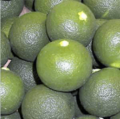 |
Citrus sudachi | Sudachi is another small, green, sour citrus, similar to Kabosu. It's a popular seasoning in Japanese cuisine. |
| Tachibana | 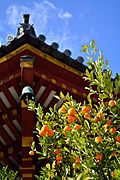 |
Citrus tachibana or Citrus reticulata var. tachibana | The Tachibana is a very old and traditional Japanese citrus. It's often seen as a symbol of Japan. |
| Tankan | Citrus poonensis × Citrus sinensis | Tankan is a sweet and juicy citrus, a mix between a Ponkan and an orange. | |
| Yukou | 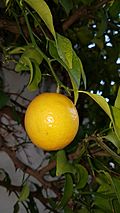 |
Citrus yuko | The Yukou is a rare citrus fruit. It has a unique aroma and is used in some special dishes. |
| Yuzu |  |
Citrus junos | Yuzu is a very fragrant and sour citrus. It's widely used in Japanese cooking, from sauces to desserts, and even in hot baths! |

All content from Kiddle encyclopedia articles (including the article images and facts) can be freely used under Attribution-ShareAlike license, unless stated otherwise. Cite this article:
Japanese citrus Facts for Kids. Kiddle Encyclopedia.


